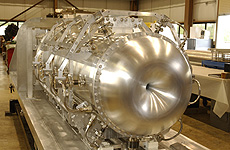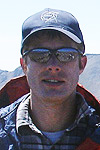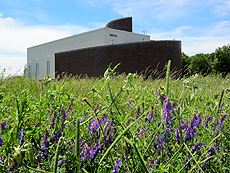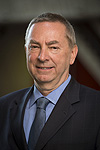|
|
Accelerator Division demonstrates Booster Neutrino Beamline operations
 |
After five months of down time, the Booster Neutrino Beam
is once again running now that a new horn, similar to the one
pictured, is installed. Photo: Reidar Hahn
|
After five months of repairing and retooling the Booster Neutrino Beamline, on June 22 members of the Accelerator Division successfully delivered beam to the BNB.
The previous horn (BNB-2) was found to be inoperable in January when it was determined its cooling was no longer working adequately. A new horn, BNB-3, was installed, and beam returned last week.
Not only was the horn cooling working poorly, but also the equipment to move the horn into and out of place, the adjuster platform, would no longer operate. (It had been designed for a very short, few-year run. It has now been 13 years.) A team in the Target Systems Department led by Kris Anderson rapidly devised, fabricated, installed and operated a new adjuster platform. They also developed a procedure to remove the BNB-2 horn, bypassing the inoperative adjuster platform. Finally, they put in place a new procedure to remove the original platform itself, which had been built in-place.
The BNB will continue to operate until the accelerator shutdown, scheduled to begin July 4. After the shutdown ends in October, it will provide beam for a three-year run of the MicroBooNE experiment. In the long term, members of the Accelerator and Neutrino divisions are developing plans to modify the BNB to provide a more intense beam for the Short-Baseline Neutrino program.
The target hall operation required rapid innovation, often on the spot, to deal with devices that had not been designed for this work. Congratulations to the Accelerator Division on this challenging operation and the return of the neutrino beam.
—Bob Zwaska, Accelerator Division
|
Patrick Fox wins Humboldt Fellowship for Experienced Researchers
 |
|
Patrick Fox
|
Fermilab scientist Patrick Fox was recently awarded the Humboldt Fellowship for Experienced Researchers for his work in theoretical physics.
Roughly 500 Humboldt Research Fellowships are given annually. They go to scientists who work at the level of assistant professor or junior research group leader or have a record of several years of independent academic work. The fellowship allows researchers to carry out long-term research in Germany. Applicants choose their own topics of research and their academic host.
Fox's work, to be carried out with Professor Joachim Kopp in Mainz, will focus on the connections between dark matter and the Standard Model. One of the questions they plan to address is whether novel measurement and analysis techniques can increase the sensitivity of direct dark matter searches beyond the limit imposed by the background of solar and atmospheric neutrino interactions, the so-called neutrino floor.
|
Flowers at MINOS
 |
Purple vetch blooms in front of the MINOS building. Photo: Georgia Schwender, OC |
|
In memoriam: Catherine Newman-Holmes
A memorial service for Fermilab scientist Catherine Newman-Holmes, who passed away recently, will be held this Thursday, July 2, at the Unitarian Universalist Society of Geneva, 102 S 2nd Street. The service will take place from 2-3 p.m. and will be followed by a reception.
|
The dawning of DUNE
From Black Hills Pioneer, June 29, 2015
LEAD — It sounds like the plot of a science fiction blockbuster: An international team of scientists is hard at work on a cutting edge experiment to beam trillions of curious particles some 800 miles straight through the earth, from a national accelerator lab in rural Illinois to four massive particle detectors in an abandoned gold mine a mile below the streets of small town in South Dakota's Black Hills.
But it's all true.
Read more
|
|
Physics Advisory Committee
 |
Fermilab Director
Nigel Lockyer
|
What do CERN director general designate Fabiola Gianotti, former CMS spokesperson Sir Tejinder Virdee and Berkeley Lab Physics Division head Natalie Roe all have in common? They are all former members of the Fermilab Physics Advisory Committee. Since prehistoric times, the PAC has been the primary mechanism for Fermilab directors to solicit advice on the Fermilab science program from leading experts of the global particle physics community. We are very fortunate that the best and the brightest of our field are willing to travel long distances to devote substantial amounts of time and energy to helping us.
The PAC meets two or three times per year, but traditionally the summer meeting is a longer retreat allowing for more detailed discussions and considerations of scientific strategy. Our meeting last week was held at the University of Chicago's Gleacher Center, where over four days the Fermilab management engaged with the 16 current members of the PAC, chaired by Daniela Bortoletto of Oxford.
Not surprisingly the PAC spent a lot of time discussing the rapid progress on the new neutrino initiatives, both the long-baseline DUNE/LBNF and the short-baseline SBN. They heard a report from David MacFarlane of SLAC, the chair of the recently formed Long-Baseline Neutrino Committee (LBNC). The LBNC is an offshoot of the PAC designed to concentrate on DUNE/LBNF and meet with the greater frequency merited by the fast pace and large scale of this evolving program.
The PAC gave special attention to SBN, the newly launched experiment that will combine the MicroBooNE, ICARUS and SBND liquid-argon detectors to understand short-baseline neutrino anomalies that might be related to sterile neutrinos. With MicroBooNE poised to begin data taking soon, we expect to learn an enormous amount in the coming year about how to efficiently reconstruct neutrino events in liquid argon. The laboratory will need to ensure a coordinated effort to rapidly disseminate this new expertise to SBN as a whole and to DUNE.
Another major role of the PAC is to give specific recommendations on the scientific and programmatic merit of proposals for new experiments. Last week they discussed an extensive proposal from the CAPTAIN-MINERvA collaboration, which aims to combine the CAPTAIN liquid-argon detector with the already operating MINERvA detector in the NuMI neutrino beam. The goal is to make measurements of neutrino interactions with argon nuclei that could eventually be critical inputs for extracting precise results from the DUNE experiment.
I have not even mentioned the extensive PAC discussions of our muon program, CMS, our test beams and the cosmic frontier. This is a hard-working committee! Even more important, I have found their advice to be frank and quite often adding new dimensions of insight, beyond our standard DOE review processes, on where we can do better. Thanks also to Fermilab's Steve Geer and Hema Ramamoorthi for organizing and running this challenging meeting.
|
Fermilab wins EPEAT Purchaser Award
Last week Fermilab became one of 17 recipients of the first EPEAT Purchaser Award, which recognizes excellence in the green procurement of electronics. Fermilab was also one of nine three-star award winners, the highest level that can be achieved.
The combined efforts of the 2015 EPEAT Purchaser Award winners resulted in enough energy savings to power more than 6,500 U.S. households for one year and carbon reductions equal to removing more than 11,000 passenger cars from the road for a year.
The award winners were recognized for their procurement efforts in up to three categories: PCs and displays, imaging equipment, and televisions. Award winners earned one star for each category in which they committed to purchasing environmentally preferable electronics registered in the EPEAT green-rating system.
Congratulations to the environmental officers, procurement staff, computing staff and purchasers who made this award possible.
EPEAT is the definitive global rating system for greener electronics and is managed by the Green Electronics Council.
|
Viewpoint: The littlest liquid
From Physics, June 29, 2015
At the world's most powerful particle accelerators, physicists collide high-energy heavy nuclei to create a soup of particles known as quark-gluon plasma (QGP). This state of matter doesn't (as was initially expected) behave like a gas of quarks and gluons, but rather like a continuous liquid that, at four trillion degrees Celsius, is the hottest liquid ever created in the lab. So far, researchers have largely focused on plasma produced from collisions between large nuclei, such as gold and lead, each of which contains hundreds of protons and neutrons. Now, experiments from the Compact Muon Solenoid (CMS) Collaboration at CERN's Large Hadron Collider provide new evidence that the liquidlike state can, unexpectedly, be created from a much smaller number of particles.
Read more
|
|